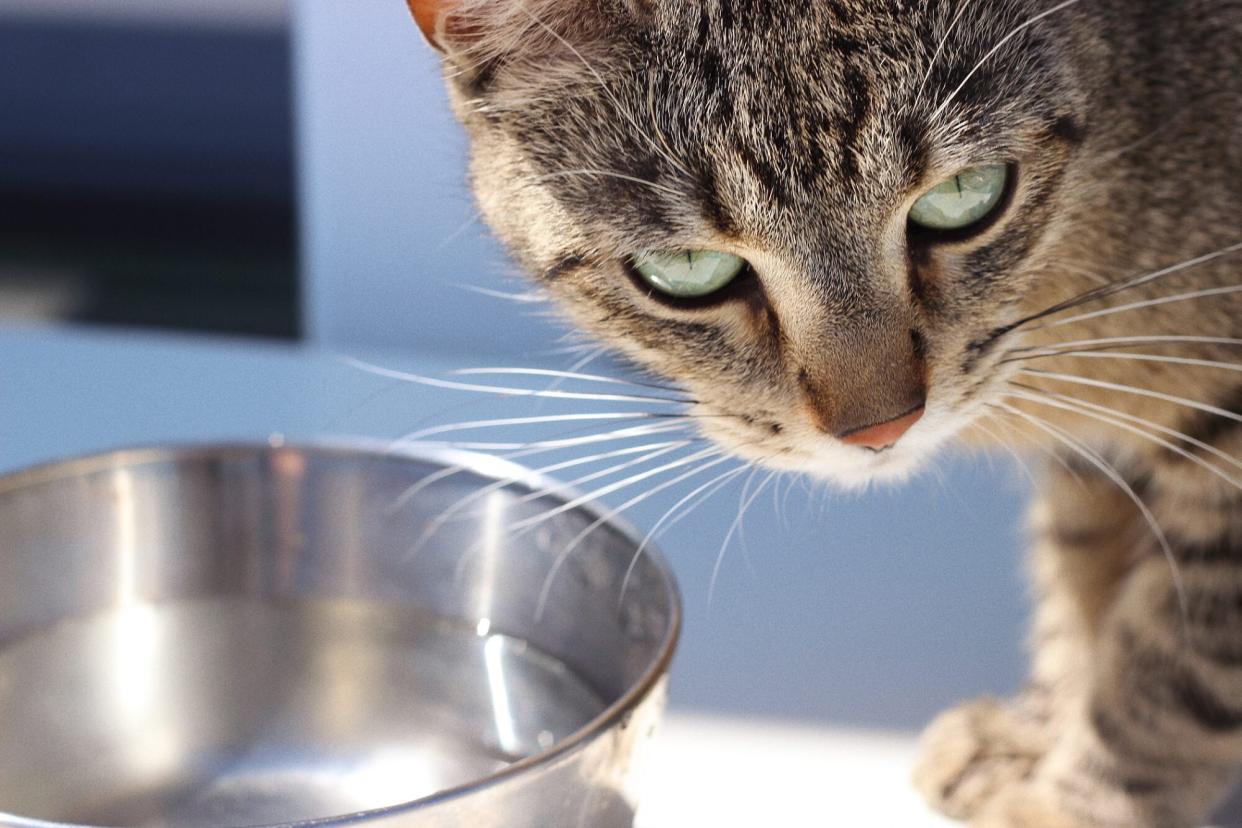How Long Can Cats Go Without Water? A Day at Most

Umniya Gad / EyeEm
TABLE OF CONTENTS
On This Page
How Much Water Do Cats Need?
How Long Can a Cat Go Without Water?
Reasons Your Cat Isn't Drinking Water
What To Do If Your Cat Isn't Drinking Water
Most cat lovers understand they often have no idea what their feline friends are up to between the hours of dusk and dawn when these furballs are more active. But they might be concerned if they don't see their kitty drinking water, especially if the dish looks untouched.
How long can cats go without water? No more than 24 hours, says Tarina L. Anthony, DVM, owner and medical director of Aurora Cat Hospital and Hotel in Aurora, Colo.
RELATED: How Long Can Cats Go Without Food?
How Much Water Do Cats Need?
Anthony says the vast majority of healthy cats don't need their water intake measured precisely, but there's a general formula most veterinarians recommend. "The normal water intake for a cat is highly individually variable, but ranges from 40–60 milliliters [approximately ¼ cup] per kilogram of body weight per day have been purported as 'normal'—though 20–70 milliliters per kilogram per day might be normal," she says.
This means if the average cat weighs 5 kilograms (11 pounds) he should drink about 250 milliliters of water daily, which is roughly one cup. The most important thing is to get an idea of your cat's "normal" habits and patterns so you can alert your vet if his water intake goes up or down.
She adds that, depending on the specific requirements for how much to feed your cat, your vet may also calculate the amount of water based on caloric needs related to ideal body weight. "The intake calculations are often used when increase or decrease in water intake is suspected, or in the hospital setting."
How Long Can a Cat Go Without Water?
Historically, cats are desert animals. "That means healthy cats are quite good at maintaining their hydration status with relatively little water, often derived from their food," Anthony explains. "It's also why they make a very concentrated—and smelly—urine."
Yet they still need water and can't survive longer than two or three days without access to it. "Once about 24 hours pass without water, dehydration sets in," she says. "The longer this goes on, the more stress and strain is placed on their internal organs, leading eventually to failure and death."
How long can sick cats go without water? Don't let that happen, as they're more prone to severe dehydration, especially if they're already vomiting or having diarrhea and losing body water that way, and can get into trouble even faster. Kitties suffering from hyperthyroidism, kidney disease, or diabetes mellitus tend to be more thirsty as well.
"If you're concerned about the hydration status of your cat, you can gently pinch and lift the skin on the back of their neck," Anthony suggests. "The skin should 'snap' back quickly. If the skin stays tented or you're unsure, contact your veterinarian."
Reasons Your Cat Isn't Drinking Water
Anthony says many cat owners don't actually notice their cats sipping water, and this may not be abnormal—after all, they don't twist and turn between our feet begging for liquid refreshment like they do food!
However, there are some particular reasons why your cat avoids his water bowl:
Cleanliness. "If the water is dirty or old, or the bowl is murky or slimy, he might not want to drink," Anthony says.
Illness or pain. If it's physically challenging for him to get to the water source comfortably, he could have a decreased intake.
An all-dry diet. "Some studies have shown that cats fed all-dry diets actually had decreased water intake," she adds. "This seems counterintuitive to many people but should be considered if your cat is on an exclusively dry diet."
Finicky felines can be rather particular about the location of their water source, too. Next to the litter box, for example? Um, no thank you. "Some behaviorists have remarked that cats also don't want their food and water sources to be too close together, but I've not personally found that to be an issue," Anthony says.
What To Do If Your Cat Isn't Drinking Water
What else might help your kitty stay hydrated? One or two of these tips might just do the trick.
Provide canned food, which usually contains 70–80 percent water and is typically enough for a healthy cat without underlying issues, Anthony points out.
Mix warm water into canned food.
Anthony also suggests sparking their curiosity by dropping an ice cube or two into the water, or add a few drops of canned tuna juice or low-sodium chicken broth.
Set up a pet water fountain, and make sure to wash it regularly, as even with a filter, mildew and mold can build up the reservoir.
Wash water bowls frequently, too, and decalcify them if necessary to remove water deposits.
RELATED: 4 Simple Ways to Get Your Cat to Drink More Water
"It's important to note that not every cat will like every trick. It may take some trial and error to find out what works best for yours," Anthony adds. "Also consider Purina Hydracare, which has been developed to help boost water intake and retention. It's a highly palatable broth placed in a clean bowl next to the food and water dishes." Be sure to discuss any supplements with your vet before introducing them to your cat.

